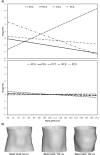Modelling of human torso shape variation inferred by geometric morphometrics
- PMID: 35271672
- PMCID: PMC8912174
- DOI: 10.1371/journal.pone.0265255
Modelling of human torso shape variation inferred by geometric morphometrics
Abstract
Traditional body measurement techniques are commonly used to assess physical health; however, these approaches do not fully represent the complex shape of the human body. Three-dimensional (3D) imaging systems capture rich point cloud data that provides a representation of the surface of 3D objects and have been shown to be a potential anthropometric tool for use within health applications. Previous studies utilising 3D imaging have only assessed body shape based on combinations and relative proportions of traditional body measures, such as lengths, widths and girths. Geometric morphometrics (GM) is an established framework used for the statistical analysis of biological shape variation. These methods quantify biological shape variation after the effects of non-shape variation-location, rotation and scale-have been mathematically held constant, otherwise known as the Procrustes paradigm. The aim of this study was to determine whether shape measures, identified using geometric morphometrics, can provide additional information about the complexity of human morphology and underlying mass distribution compared to traditional body measures. Scale-invariant features of torso shape were extracted from 3D imaging data of 9,209 participants form the LIFE-Adult study. Partial least squares regression (PLSR) models were created to determine the extent to which variations in human torso shape are explained by existing techniques. The results of this investigation suggest that linear combinations of body measures can explain 49.92% and 47.46% of the total variation in male and female body shape features, respectively. However, there are also significant amounts of variation in human morphology which cannot be identified by current methods. These results indicate that Geometric morphometric methods can identify measures of human body shape which provide complementary information about the human body. The aim of future studies will be to investigate the utility of these measures in clinical epidemiology and the assessment of health risk.
Conflict of interest statement
The authors have declared that no competing interests exist.
Figures









References
-
- Treleaven P. Sizing us up. IEEE Spectrum. 2004;41(April):29–31.
Publication types
MeSH terms
LinkOut - more resources
Full Text Sources

